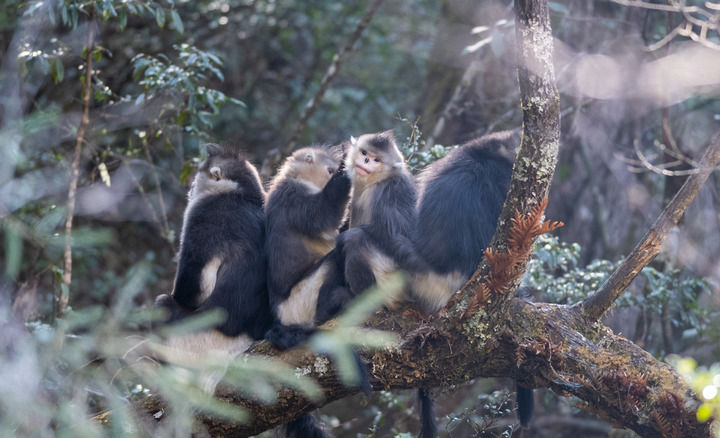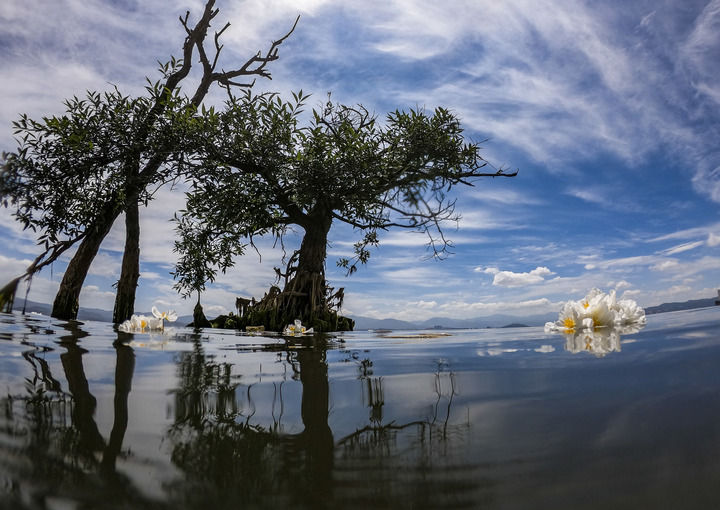Xinhua News Agency, Kunming, September 26th Title: Yunnan: depicting a new picture of harmonious coexistence between man and nature
Xinhua News Agency reporter Wang Changshan Li Huaiyan Zheng Bofei Zhao Peiran
From protecting Yunnan golden monkey to stopping the construction of hydropower station for green peacock, from Asian elephant returning to the north and south to hundreds of millions of butterfly outbreaks … … In the past ten years, the population of many rare and endangered animals and plants in Yunnan has increased, the distribution area has increased and expanded, and the story of harmonious coexistence between man and nature has been constantly staged.
Yunnan, which has the reputation of "animal and plant kingdom" and "species gene bank", accounts for 4.1% of the country’s land area. The number of biological species in all major groups is close to or more than half of the number of similar species in China, and many species are only distributed in Yunnan.
The data shows that the number of Asian elephants in Yunnan has increased to more than 360, and the number of Yunnan golden monkey has increased to about 3,800. Flagship species such as green peacock and white-browed gibbon have also achieved steady growth. Thirty species of extremely small population plants, such as the "giant panda" Hua Gaimu, have been rescued from the threat of extinction by in-situ protection, ex-situ protection or breeding return.

Yunnan Golden Monkey in Shangri-La Yunnan Golden Monkey National Park, Diqing Tibetan Autonomous Prefecture, Yunnan Province (photo taken on March 16, 2021). Xinhua News Agency reporter Hu Chao photo
public participation
In June this year, butterflies in Honghe Butterfly Valley in Jinping County, Yunnan Province entered an outbreak period, with a total number of more than 100 million. The butterflies flying all over the sky formed a seasonal landscape that is rare in the world.
In order to protect this precious landscape, Jinping County issued the regulations on the protection and management of Butterfly Valley, invited experts and scholars from the industry to come to Butterfly Valley for scientific research, studied biodiversity-related protection measures, and organized the compilation of popular science books on butterfly protection, so that children could establish the awareness of protecting biodiversity at an early age.
The villagers in Ma ‘andi Township spontaneously set up a colorful butterfly professional cooperative. Wu Ziwen, a villager engaged in butterfly breeding, said that butterflies are a gift from nature. Now more and more villagers are involved in butterfly protection, and there are more and more kinds of butterflies.
In Mankelao Village, Kangping Town, Jiangcheng County, Pu ‘er City, villagers Diao Faxing’s task is to monitor, track and observe elephants. "Elephants can feel people’s goodwill, so they are not afraid to be close to people now." Yan Faxing said. In Jiangcheng County, there are 10 elephant monitors like him.

Asian elephants feed in a village in Jiangcheng Hani and Yi Autonomous County, Pu ‘er City, Yunnan Province (photo taken on August 1, 2022). Xinhua News Agency reporter Jiang Wenyao photo
Yu Xiaode, a villager in Xiangguqing Village, Tacheng Town, Diqing Prefecture, who is over 60 years old, goes up the mountain at 8 o’clock in the morning and down the mountain at 4 o’clock in the afternoon. He has become "friends" with the Yunnan golden monkey in the mountain and clearly remembers the name and cry of each monkey. Once a hunter, he is now an ecological ranger and monkey keeper.
Yu Xiaode said that the villagers used to make a living by hunting and logging, and the destruction of their habitat reduced the number of monkeys. In order to save the endangered Yunnan golden monkey, Baima Snow Mountain National Nature Reserve combines protection with the survival and development of surrounding residents to promote the restorative growth of Yunnan golden monkey population.
"At the beginning of the construction of the reserve, the population of Yunnan golden monkey was less than 500." He said that there are now more than 2,300 Yunnan golden monkeys distributed in the reserve.

Yunnan golden monkey photographed in Baima Snow Mountain National Nature Reserve, Yunnan (photo taken on March 13, 2022). Xinhua News Agency reporter Wang Guansen photo
In Xiangguqing Village alone, there are dozens of forest rangers guarding the mountain forest. Farming and the income of rangers have solved the problem of increasing their income. According to the introduction of Yunnan Forestry and Grassland Bureau, 183,000 ecological rangers have been employed in the province, and a normalized monitoring system has been established for flagship species such as Asian elephant, green peacock, Yunnan golden monkey and Gaoligong white-browed gibbon.
Guarding habitat
Cao Yongheng, inspector of the Yunnan Provincial Department of Ecology and Environment, said that Yunnan is committed to building a scientific and reasonable nature reserve system. In the past ten years, 90% of the typical ecosystems and 80% of the key protected wildlife species in the province have been effectively protected.
The data shows that there are 362 nature reserves in Yunnan, accounting for 14.32% of the province’s total area. Efforts are made to form a protected area structure with national parks as the main body, nature reserves as the foundation and natural parks as the supplement.
In the hometown of huagaimu, a rare and endangered plant, the nature reserve successfully saved this endangered tree species called "plant giant panda" through in-situ protection.
According to Wu Daiqiong, director of the Management and Protection Branch of Xichou County National Nature Reserve, due to the lack of mature seeds and low natural regeneration ability, the reproductive ability of the Chinese cover wood population is weak. Previously, there were only 52 wild huagai trees, so it was necessary to introduce and cultivate them artificially, and then transplant them back to their original place after they survived.
In the past ten years, hundreds of Cephalotaxus sinensis plants have been transplanted back to their original places through artificial cross-pollination of Cephalotaxus sinensis.
As the only native peacock in China, Green Peacock is distributed in the west of Yunnan, with a population of about 600, which is an extremely endangered species. Among them, about 300 green peacocks live in Shuangbai Dinosaur River State Nature Reserve.
Because the hydropower projects on Shuangbai and Xinping rivers may affect the green peacock habitat, on December 31, 2020, following the relevant laws on environmental resources protection, the Yunnan Higher People’s Court ruled in the second instance that the construction project of Jiasajiang I Hydropower Station, which may cause great risks to the green peacock habitat, should be stopped immediately. The trial of this case, with the concept of "protection first, prevention first", saved the home on which the green peacock depended.
James Thornton, founder and CEO of Klines European Environmental Protection Association (UK), said that the Yunnan Green Peacock case is a landmark case with demonstration significance to the whole world.
a community of life
As the second batch of integrated protection and restoration projects of landscape, forest, field, lake, grass and sand in China, the water quality of Erhai Lake in Dali has become an important touchstone for biodiversity protection in Yunnan.
Cauliflower is the main ingredient of Dali Bai nationality’s "seaweed taro soup", which once spread all over the surface of Erhai Lake. The growth of cauliflower needs excellent water quality, and the turbid water environment and eutrophication of water quality will limit the survival of cauliflower.
However, due to the population growth and pollution around the lake, seaweed was not seen in Erhai Lake for a time. Simomo, a villager from Jiapeng Village who grew up near Erhai Lake, planted several cauliflower plants in a small pond at home, hoping to leave traces of them.
In order to retain the beautiful scenery of Erhai Lake, during the "Thirteenth Five-Year Plan" period, Dali invested a total of 32.98 billion yuan to control Erhai Lake, vacated 1,029 mu of coastal land, and built an ecological corridor around the lake and a lakeside buffer zone … …
In recent years, the main water quality of Erhai Lake has gradually improved, and the water quality has remained in Class II for a long time, and seaweed has returned to Erhai Lake. Nowadays, Simomo often looks at the clear water of Erhai Lake at home and tells the story of seaweed to tourists.

Seaweed flowers in Erhai Lake (photo taken on May 31, 2020). Xinhua News Agency reporter Jiang Wenyao photo
In Xishuangbanna, some once hard-to-find traditional Dai medicinal materials have also returned to nature. For a long time, almost every Dai village will protect a water source forest, which is a biodiversity community full of Dai medicinal materials.
"Zhu Jiao can cure stomachache, and ships can clear fire and detoxify … …” Yan Jiao, a villager in Mandian Village, said that the villagers increased their income by planting traditional Dai medicine under the forest, and their enthusiasm for protecting the forest was higher.
In 2021, with the participation and promotion of the United Nations Development Programme, the Global Environment Facility and other organizations, Xishuangbanna launched a pilot project of "establishing and implementing a national framework for the acquisition and benefit sharing of genetic resources and related traditional knowledge", which promoted the application of Dai medicine and made exploration and practice in strengthening the utilization and benefit sharing of biological genetic resources.
At present, the forest coverage rate in Xishuangbanna is 81.3%. "Where there is forest, there is water; where there is water, there is field; where there is field, there is food; where there is food, there is people." This proverb circulating in the local area interprets the simplest concept of harmonious coexistence between man and nature. (Video reporter: Sun Min Wang Haowei)
Producer: Zhao Danping and Li Zhiang
Coordinator: Li Kai, Hou Dongtao, Yang Yong and Xia Xiaopeng.
Produced by Xinhua News Agency’s International Communication Integration Platform